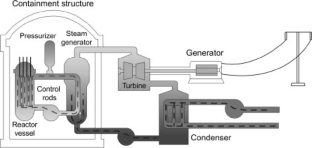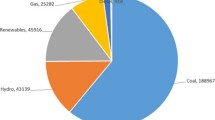Abstract
Global carbon emissions have been rising sharply since the start of the 20th century, and countries have adopted various policies in recent years to reduce greenhouse gas (GHG) emissions in different sectors. Nuclear energy is one energy source that is least polluting with minimum GHG emissions. India’s nuclear power programme started with Heavy water reactors in the first stage followed by Fast Reactors in the second stage. Third stage of Thorium utilisation is yet to start. The deployment of Pu/depleted U from Heavy water reactors in fast reactors would help in the effective utilisation of the indigenous uranium resources to a large extent besides reducing the waste. The thorium technology to obtain uranium 233 is equally important as India possesses large amounts of thorium deposits. With sufficient U233 we can provide a significant long-term solution to fuel our nuclear reactors to produce electricity needed for its development. Linked to the nuclear programme is the availability of fuel, ability to reprocess the spent fuel and manage the wastes. India’s waiver from the Nuclear Suppliers’ Group and its agreement with the global atomic energy body, IAEA, have resulted in limited breakthroughs in the nuclear sector in the last decade and allowed the import of fuel. This paper undertakes a review of the different steps taken by India in the nuclear arena and makes a realistic assessment of its current nuclear power programme.





Similar content being viewed by others
Abbreviations
- GHG:
-
Greenhouse emissions
- IAEA:
-
International Atomic Energy Agency
- DAE:
-
Department of Atomic Energy India
- PHWR:
-
Pressurised heavy water reactor
- RAPS:
-
Rajasthan Atomic Power Station
- PWR:
-
Pressurised water reactor
- BWR:
-
Boiling water reactor
- SFR:
-
Sodium fast reactor
- CANDU:
-
Canada Deutrium
- RBMK:
-
Reaktor Bolshoy Moshchnosty Kanalny
- GCR:
-
Gas cooled reactor
- FBR:
-
Fast breeder reactor
- VVER:
-
Vodo-Vodyanoi Energetichesky Reaktor
- EBR-1:
-
Experimental breeder reactor I
- AEC:
-
Atomic Energy Commission
- AEET:
-
Atomic Energy Establishment, Trombay
- BARC:
-
Bhabha Atomic Research Centre
- FBTR:
-
Fast breeder test reactor
- AECL:
-
Atomic Energy of Canada Limited
- PNE:
-
Peaceful nuclear explosion
- MOX:
-
Mixed oxide
- MAPS:
-
Madras Atomic Power Station
- NFC:
-
Nuclear fuel complex
- KAPS:
-
Kakrapar Atomic Power Station
- NAPS:
-
Narora Atomic Power Station
- TAPS:
-
Tarapur Atomic Power Station
- NPCIL:
-
Nuclear Power Corporation of India
- KAMINI:
-
Kalpakkam mini reactor
- PFBR:
-
Prototype fast breeder reactor
- CORAL:
-
Compact reprocessing of advanced fuel
- FRFCF:
-
Fast reactor fuel cycle facility
- MSR:
-
Molten salt reactor
- AHWR:
-
Advanced heavy water reactor
- EPR:
-
Evolutionary power reactor
- AERB:
-
Atomic Energy Regulatory Board
- MOEF:
-
Ministry of Environment and Forests
- IDC:
-
Interest during construction
References
Iyer M R 2020 The Saga of Atomic Energy in India- Why is Nuclear Power still Subcritical? Authors Press, Delhi
Sarma N and Banerjee B 2008 Nuclear Power in India: A Critical History. Rupa & Co., Delhi
Hart D 1983 Nuclear Power in India: A Comparative Analysis. George Allen & Unwin, London. https://doi.org/10.4324/9780429278303
Bhardwaj SA 2013 Indian nuclear power programme—Past, present, and future, S ̄adhan ̄a 38: Part 5, pp. 775–794
Kale R D 2020 India’s fast reactor programme—A review and critical assessment. Progress Nuclear Energy 122: 103265
Vaidyanathan G and Purniah B 2020 Energy, and Environment- from Cradle to Grave. Yes Dee Publishing, Chennai
Grover RB 2006 Role of Nuclear Energy in India’s Energy Mix, IANCAS Bulletin, April
Uwe R Fritsche et al., Energy and Land Use, September 2017, International renewable energy Agency IRENA& UN Convention to Combat, desertification, http://iinas.org/tl_files/iinas/downloads/land/IINAS_2017_UNCCD-IRENA_Energy-Land_paper.pdf
Neumeyer C and Goldston R 2016 Dynamic EROI Assessment of the IPCC 21st Century Electricity Production Scenario Sustainability 2016, 8, 421. https://doi.org/10.3390/su8050421
IAEA-TECDOC-892, Comparison of Energy Sources in Terms of Their Full-Energy-Chain Emission Factors of Greenhouse Gases, IAEA, Vienna, 1996
Nuclear Electricity Generation: What Are the External Costs? OECD, NEA4372, Nuclear Energy Agency, 2003. https://www.oecd-nea.org/jcms/pl_13756/nuclear-electricity-generation-what-are-the-external-costs?details=true
IAEA 2006 Nuclear Power Reactors in the World, International Atomic Energy Agency (IAEA). Austria, Vienna
Balachandran G and Kapil Patil K 2012 Nuclear Power Plant and Civil Nuclear Liability, Institute for Defence Studies and Analysis, Delhi
Shah JC et al. 1977 Experience from the Construction and Operation of Tarapur and Rajasthan Nuclear Power Station" [IAEA-CN-36/360 (VII.3)], Salzburg Conference
Sundaram CV, Krishnan LV and Iyengar TS 1998 Atomic energy in India: 50 years. Department of Atomic Energy, New Delhi
Agreement for cooperation between the Government of India and the Government of United States of America concerning peaceful uses of nuclear energy (2007). http://www.meaindia.nic.in/pressrelease/2007/08/03pr01.pdf
Sarma MSR, Sah BML and Subbaratnam T 1981 Dousing incident at RAPS Unit I, Regional seminar for Asia and the Pacific Region—radiation emergency preparedness (health physics and medical aspects), Kalpakkam, India, 30 Nov 1981
Sinha RK et al 2010 Plant life management (PLIM) practices for pressurised heavy water nuclear reactors (PHWR) in understanding and mitigating ageing in nuclear power plants Materials and operational aspects of plant life management (PLIM), Edited by Philip G. Tipping, Wood Head Publishing, pp. 739–794
Grover R B and Srinivasan M R 2020 Vikram Sarabhai: his vision for the development of atomic energy in India. Curr. Sci. 118(8): 1191–1195
Bharadwaj A, Krishnan LV and Rajagopal S 2017 Nuclear viewpoint in India, MRS energy & sustainability: a review. J. Mater. Res. Soc., 4, Article number: 6
Sharma S and Mukherjee SP 2009 A Dream Comes True- The Saga of Heavy Water Production in India, Heavy Water Board, Mumbai
Bhasin V, Kushwaha HS and Kakodkar A 2011 Failure Analysis of MAPS Inlet Manifold. In Transactions of the 11th International Conference on Structural Mechanics in Reactor Technology, Tokyo
Kakodkar A 2019 Fire and Fury Rupa publications, 2019, P49 & 53
Sundarrajan AR, Parthasarathy KS and Sinha S 2008 Atomic Energy Regulatory Board- 25 years of Safety Regulation. https://www.aerb.gov.in/images/PDF/Silver_Jubilee_Book/SJBook.pdf0
Murugan S et al. 2013 Irradiation testing of zirconium alloys and stainless steel in fast breeder test reactor, India. In Effects of Radiation on Nuclear Materials: 25th Volume, ed. T. Yamamoto, M. Sokolov, and B. Hanson (West Conshohocken, PA: ASTM International), pp. 176–191
https://www.iaea.org/resources/databases/power-reactor-information-system-pris
Basu P C and Gupchup V N 2004 Safety evaluation of rehabilitation of delaminated containment dome. Nucl. Eng. Des. 228: 195–205
Rajamani N 2017 Reprocessing of spent nuclear fuel in India: present challenges and future programme. Prog. Nucl. Energy 101: 118
Manoharan N, Suresh Kumar KV and Srinivasan G 2011 Fifteen years of operating experience of Kamini Reactor, IAEA
Tongia R and Arunachalam V S 1998 India’s nuclear breeders: Technology, viability and options. Curr. Sci. 75(6): 549
RaoKR2001, Radioactive waste: the problem and its management. Curr. Sci. 81(12): 25
Nagarajan K et al. 2011 Development of pyrochemical reprocessing for spent metal fuels. Energy Procedia 7: 431
Jess CG 2015 History of the ORNL molten salt program. In Workshop on Molten Salt Reactor Technologies, Oak Ridge National Laboratory
Paranjpe SR 1998 Fast Breeder Reactor Development in India (unpublished)
Vijayan P K 2015 Conceptual design of Indian molten salt breeder reactor. Pramana J. Phys. 85(3): 539
Nayak AK et al. 2019 Thorium technology development in an Indian perspective. In Thorium—Energy for the Future, A. K. Nayak and B. R. Sehgal (eds.), Springer Nature
Kakodkar A et al. 2019 Nuclear Power: India’s Development Imperative, Report Vivekananda International Foundation, Delhi
Grover R B 2017 The civil liability for nuclear damage act of India: An engineering perspective regarding Supplier’s liability. Prog. Nucl. Energy 101: 168
Grover R B and Puri R R 2013 Development of human resources for Indian nuclear power programme. Sadhana 38(5): 1051–1064
Bajaj S S 2013 Regulatory practices for nuclear power plants in India. Sadhana 38(5): 1027–1050
Mishra L 1999 India's Quest for Technological Self- Reliance, PhD Thesis, Jawaharlal Nehru University, Delhi
Lok Sabha Secretariat 1994 Ninth Report Standing Committee on Energy, Department of Atomic Energy Demands for Grants (1994-95) Presented to Parliament




